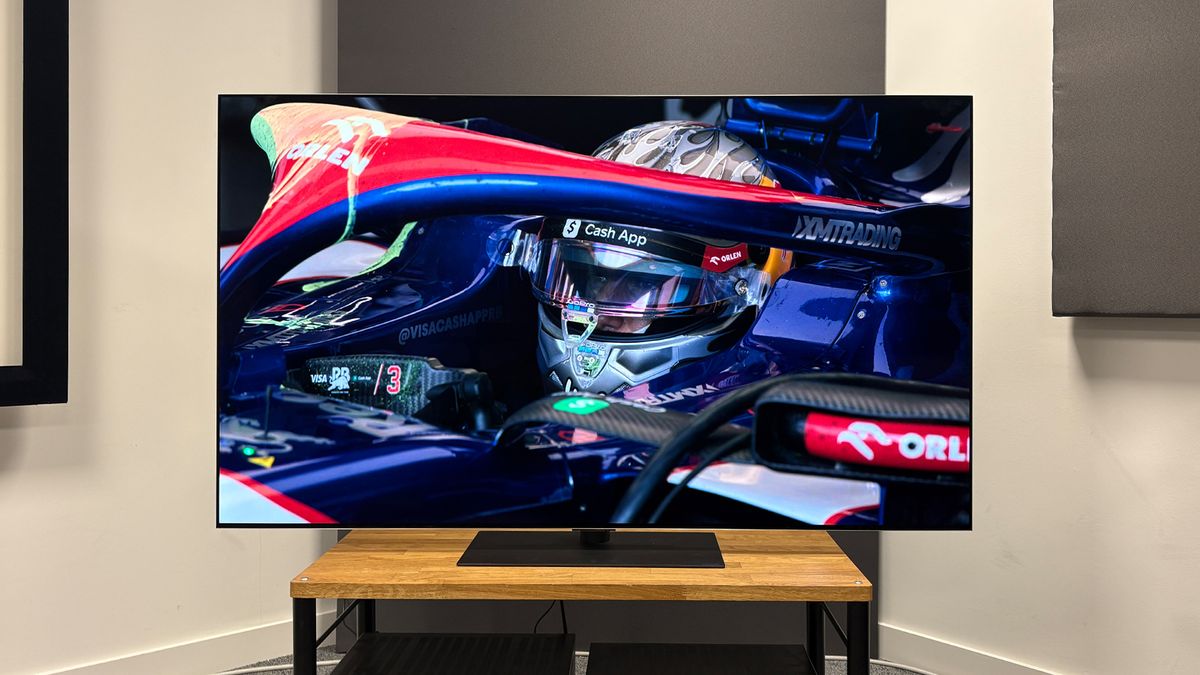What Hi-Fi? Verdict
The LG G5 is in almost all regards a stunning set and a leap forward for OLED TV technology – it’s just a shame that a nasty Dolby Vision flaw holds it back
Pros
- +
Dazzlingly bright image
- +
Crisp and colourful picture
- +
Excellent feature set for gamers
Cons
- -
Glaring Dolby Vision streaming issue
- -
Dull sound
Why you can trust What Hi-Fi?
Let’s not beat around the bush; you’ve seen the star rating. LG’s flagship OLED G-series has, for the past four generations, earned five stars for excellent picture quality and uncompromising feature sets.
So the latest and greatest generation, with its brand-new OLED panel technology, should surely continue that winning streak.
In most ways, it does. The G5 combines the winning formula of previous G-series models with an exciting new Primary RGB Tandem OLED panel to dazzling effect.
But there's an issue with the way the TV handles streamed Dolby Vision content. Considering how much of that most owners will watch, that's a big problem – certainly big enough to prevent the G5 from troubling the very best OLED TVs.
Price
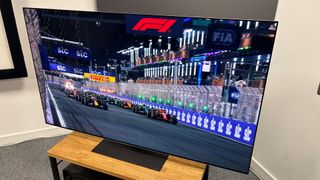
The LG G5 is a flagship-level 4K OLED TV, with a premium price tag of £3299 / $3400 / AU$5299 for the 65-inch model that we have before us today.
Much like the G4, it also comes in screen sizes of 55, 65, 77, 83, and 97 inches; this year, though, LG has expanded the lineup with a 48-inch model for the first time.
Pricing for the full range is as such:
Size | G5 | G4 |
|---|---|---|
48 | £1800 / $TBC / AU$TBC | No such model |
55 | £2400 / $2500 / AU$4199 | £2400 / $2600 / AU$4199 |
65 | £3300 / $3400 / AU$5299 | £3300 / $3400 / AU$5299 |
77 | £4500 / $4500 / AU$7999 | £4500 / $4600 / AU$7999 |
83 | £7000 / $6500 / AU$9999 | £7000 / $6500 / AU$9999 |
97 | £25,000 / $25,000 / AU$TBC | £25,000 / $25,000 / AU$n/a |
The good news is that the G5 is priced almost identically to the outgoing G4; and in some cases, it's actually cheaper. The 55-inch version, for example, is $100 cheaper than the G4’s launch price in the US.
We’re also awaiting pricing for comparable 2025 TVs, such as the Samsung S95F and Panasonic Z95B. UK pricing for the Sony Bravia 8 II QD-OLED set has, however, just been revealed; and in a surprising twist, the 65-inch model undercuts the equivalent G5 to the tune of £300.
Design

Much like its C5 sibling, the G5 carries forth the design from its predecessor – no great shame: we approved of the G4’s sleek and attractive build.
That being said, it would be remiss of us not to mention the fact that this design has been used since the G1, so an updated look to coincide with the new panel technology would have been a nice touch.
Nevertheless, the slender frame and stylish silver trim give the G5 an eye-catching design befitting of its “Gallery” namesake.
The G5 measures in at a universal thickness (well, thinness) of just 2.4cm; admittedly, that’s not quite as slender as the C5’s immensely thin profile. That TV, however, features a chunky box-out which breaks the illusion of continuous slimness.
The G5 comes in two versions, one bundled with LG’s Zero Gap wall mount for a flush fit and seamless wall-mounting setup, the other with a tabletop stand; note, the G5S variant (which includes the stand) is currently available only in 55- and 65-inch sizes here in the UK. The official pricing is the same for the stand and wall-mount versions.
We have the stand variant of the G5 before us today, and we approve of its minimalist styling and easy-to-assemble setup process. Furthermore, the stand can be set to two positions: there is a sleek, low-profile look, or a higher position to accommodate a soundbar.
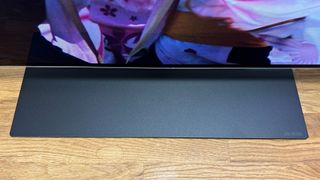
A 48-inch screen size has been a staple of the C-series OLEDs for quite some time, and LG expanded (or, should we say, shrunk) its entry-level B-series OLED to include a 48-inch version in last year’s lineup. However, this size is a first for the G series, and a rare instance of a flagship TV launching at this size.
There is a catch, however, as LG states that the smallest and 97-inch versions of the G5 won’t hit the same brightness levels as their siblings and don’t sport the new Primary RGB Tandem OLED panel.
We have seen this many times before with MLA and QD-OLED TVs, as manufacturers tend to make the panels in core sizes (55- to 83-inches), though it is a shame that the smallest flagship model won’t be on par technically with its larger counterparts.
Less new and exciting is the included remote, which, besides swapping the input control for a more generalised connected-devices hub button and adding a new AI shortcut button, is broadly unchanged from the version that came with last year’s G4 – and the G3 from 2023, come to that.
We would have liked to have seen a more premium handset with backlighting offered with the G5, but that’s unfortunately not the case – at least not for the UK.
Those looking to buy the G5 in markets outside of the UK (such as North America or South Korea) will be treated to a sleeker and more streamlined remote. This hasn’t made it over to the UK, says LG, on account of its missing number pad.
It is worth noting that brands such as Sony and Samsung get around this issue (and have done so for years) by bundling their premium TVs with two remotes – one slick, stripped-back number, and a second, old-school zapper.
Features
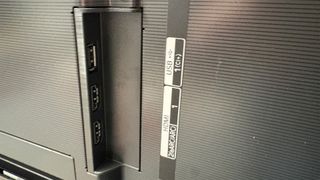
The headline feature of the G5 is that it's the first TV to launch with the new Primary RGB Tandem OLED panel – or, as it’s otherwise known, Four Stack OLED.
This new panel architecture comprises four individual OLED layers – two blue, one red and one green – to boost brightness and colour volume.
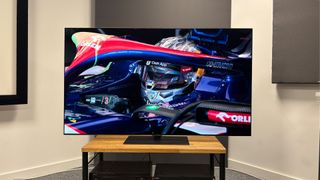
Screen size 65 inches (also available in 48, 55, 77, 83 and 97 inches)
Type OLED (Primary RGB Tandem)
Backlight N/A
Resolution 4K
HDR formats HLG, HDR10, Dolby Vision
Operating system webOS 25
HDMI inputs x4 (4 x 48Gbps HDMI 2.1)
Gaming features 4K/120Hz, 4K/165Hz, VRR, ALLM, Dolby Vision game mode, HGiG
ARC/eARC eARC
Optical output? Yes
Dimensions (hwd, without stand) 83 x 144 x 2.4cm
The G3 and G4 both featured Micro Lens Array OLED (MLA), which involves a layer of millions of microscopic lenses that focus the light output towards the viewer.
The technology worked well for its (relatively speaking) short lifespan, but it has now been completely replaced.
This means that manufacturers such as Panasonic and Philips, which have previously used MLA panels, have also transitioned to Primary RGB Tandem OLED for their respective upcoming flagship TVs.
With that important context out of the way, what does this new panel architecture have to offer? At a basic level, this new panel pushes the brightness limits of OLED to new heights.
LG Electronics remains tight-lipped about an official nit figure for the G5, but other manufacturers and LG Display have stated that this panel can reach up to 4000 nits peak brightness. Colours should appear richer and more vibrant, too, because the panel is not reliant on a white OLED to boost brightness.
As ever, headline peak brightness figures should always be taken with a pinch of salt: partly because manufacturers are prone to exaggeration; partly because the way they are measured doesn’t tally with most of what people actually watch; and finally because they are usually attainable only in the TV’s most vivid and least cinematically accurate picture preset.
That said, we have still been promised and are expecting to see a noticeable increase in brightness from the G5, in both small highlights and full-screen bright images.
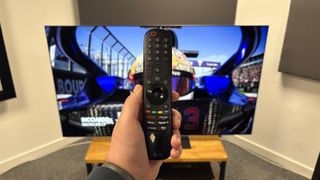
This enhanced brightness is also in part thanks to LG’s Brightness Booster Ultimate engine, which LG claims will deliver three times better brightness compared with the entry-level B5 OLED TV. This feature comes to the G5 via the new Alpha 11 AI Processor Gen2, which, as the name might suggest, is heavily built around AI.
This new processor drives many of the AI-backed functions of the G5, including the AI Picture Pro and AI Sound Pro options, both of which come with a fairly robust customisation process.
AI Picture Pro serves as an umbrella term for a range of picture-enhancement features, including AI Perceived Object Enhancer (which aims to enhance the three-dimensionality of the picture), AI Super Upscaling, and OLED Dynamic Tone Mapping.
Furthermore, you can consult the built-in AI chatbot to diagnose issues with your TV and solve them. Better yet, LG has implemented a large language model, meaning you won’t need to remember specific commands to adjust the settings. Instead, you can just say “make the picture brighter” or “I can’t hear voices very well,” and the TV will react accordingly.
As for the core AV features, the G5 supports HDR10, HLG and Dolby Vision; Samsung’s HDR10+ technology is not present. Dolby Atmos audio is also on board through the built-in 60W 4.2 channel sound system, or via audio equipment connected to the HDMI eARC socket.
Speaking of HDMI connectivity, there are four full bandwidth HDMI 2.1 sockets on the G5. These are all capable of handling 4K/165Hz (as well as 4K/120Hz, of course) signals with VRR and ALLM. That makes this an ideal gaming TV for those with both an Xbox Series X and a PlayStation 5, as well as external audio equipment.
While 165Hz won’t make a world of difference to console gamers (120Hz being the current upper limit of the Xbox Series X and PS5), it will appeal to PC gamers with capable rigs.
Furthermore, the G5 features LG’s excellent Game Optimiser feature, which gives you quick access to key gaming settings, as well as information such as frame rate and whether ALLM is enabled.
You can also access game streaming apps through the webOS 25 operating system, including the Xbox app, to stream near-console quality titles without requiring a console.
Elsewhere, the webOS platform features all of the expected streaming apps, both domestic and international; these include Netflix, Disney+, Amazon Prime Video and Apple TV, as well as BBC iPlayer, ITV X and Channel 4.
Picture

As alluded to in the introduction of this review, the G5 has a flaw that holds it back from true greatness. Before we explore that, though, we should also say that this is a truly spectacular-looking TV in most cases.
Playing a range of our go-to reference 4K discs, including Top Gun: Maverick, Pan, The Matrix, Oppenheimer, No Time to Die and Interstellar, we can assess this flagship set’s capabilities. After much testing, we also opt for the Filmmaker Mode picture preset, with TruMotion set to the Cinematic Movement setting applied and sharpness turned down to zero, as we believe these settings suit the G5 best.
What is immediately striking is how bright the new Primary RGB Tandem TV looks next to a conventional OLED. We’re talking levels that, in cases where peak-brightness highlights are on show, such as when Maverick engages the scramjet of the Darkstar hypersonic aircraft, we are compelled to shield our eyes from the blazing brightness.
Feed it some content that is specifically mastered to target a higher brightness, such as the 4K Blu-ray release of The Matrix or Pan, and it becomes apparent that the new Primary RGB Tandem OLED is truly a technical marvel.
When Neo first enters the computer simulation, the white void that he and Morbius converse in is truly striking. Here, we experiment with the Dynamic Tone Mapping feature and – unlike with the C5, which tends to benefit from the boosted brightness – we opt to turn it back off as it can over-brighten content such as this.
Moving on to Pan, the sequence in which the flying pirate ship floats through a cluster of suspended bubbles towards Neverland is both dazzling and deeply engaging, thanks to its rich, vibrant colours and excellent detail levels. The sun, which often gets lost in the bloom of brightness surrounding it, has a clear circular outline with an intensely bright core.
On the subject of colours, the G5 benefits from the enhanced colour volume afforded by the new panel technology. The bubbles mentioned above feature stunning gradations of blue and green, while the sun casts a rich golden glow across the patchwork sails.
In the same sequence, we find that skin tones are superbly realised, with a hint of red in the cheeks of the titular character, alongside a wide range of skin tones appearing well judged.
The G5 also presents a terrifically three-dimensional image. The brief shot of a watchtower in Oppenheimer looks solid and crisp, with a clear distinction between the tower in the foreground and the desert in the background.
This also highlights how sharp and detailed the G5 looks in general, with everything from environmental features to clothing and skin textures all featuring bucket loads of detail without looking over-sharpened.
Switching back to Top Gun: Maverick, we find that motion is also a key strength of this TV. As Maverick tears down the road on his Kawasaki motorcycle with reckless abandon, the G5 refuses to stutter or judder.
As mentioned, we opt to switch the TruMotion setting onto Cinematic Movement, which adds a very minor touch of motion processing to smooth out any 24fps judder.
If you are totally averse to motion processing, then you’ll want to switch TruMotion off entirely. The good news is that the G5 still handles motion very well in this setting, with very little judder.
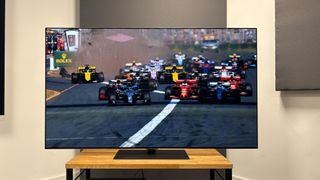
Here, though, is where we have to address the elephant in the room – or, in our case, the Xenomorph.
We switch to Alien Romulus from the Apple TV app in 4K Dolby Vision to see how the TV handles content in this HDR format. And here, the G5 makes a major stumble: the opening of the film, which features a shot of a spaceship slowly approaching, backed by the infinite void of space, looks, frankly speaking, almost unwatchable.
Played on the G5, the scene opens with a blocky ripple effect, which then highlights patchy areas of the image and lots of image noise along the borders of the display.
Furthermore, the infinite void of space is presented in an off-putting greyish hue, and when the shot approaches the window of the spacecraft, the image is overlaid with a purple-looking visual filter.
Is this a problem specific to the Apple TV app? We play the same movie via Disney+ and confirm that it isn’t.
Baffled by this discovery, we plug a Google TV Streamer into the G5 to test this scene and, sure enough, we encounter the same problem. This rules out the possibility that it is limited to just the TV’s built-in apps and suggests it's a broader issue with how the TV handles lower-bitrate Dolby Vision content, particularly darker sequences or scenes with lots of shadow detail.
To confirm this, we try the 4K Dolby Vision Blu-ray of Alien Romulus. As suspected, it doesn’t present the same issue. Instead, we are back to the TV looking its best, with deep blacks, crisp details and rich colours.
To confirm that it's specifically a Dolby Vision issue, we head back over to the Google TV Streamer, restrict it to HDR10 and play Romulus once more. Sure enough, the low-light ugliness is gone.
For final clarification, we watch sections of Interstellar and No Time To Die, both on the Apple TV app and in Dolby Vision, and we once again see the problems we first spotted with Alien: Romulus.
Lifted blacks that look closer to grey are apparent, which is not something we expected to say about an OLED TV, let alone a flagship model such as the G5. The blocky and patchy picture artefacts also return. In short, this isn't a problem with just one movie, but seemingly an issue with how the TV handles streamed Dolby Vision content in general.
The fact that the G5’s handling of streamed Dolby Vision content is, if we’re being brutal, a mess, isn’t something we can overlook.
While we all know that Blu-ray discs are best, none of us watches them exclusively. In fact, most people watch most content via streaming. And if they use the built-in apps (which is very likely), there is no way to disable Dolby Vision HDR. In other words, most owners will regularly encounter this issue – which makes it a big problem.
We have brought all of this to the attention of LG, and while we don’t yet have an official statement, we understand that it is a known issue and that a solution is in the works.
That means this streamed Dolby Vision issue might not be a problem for long; but it is a problem right now – and a big one – and we have to account for it in the G5’s star rating.
Sound
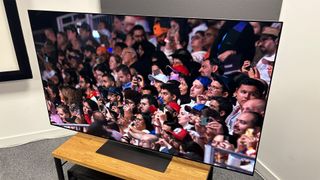
The G5’s sound is, unfortunately, less spectacular than its picture. While this was rather expected – the C5 was our first hint that LG hadn’t revolutionised its approach to built-in sound for its OLED TVs – that doesn’t negate the G5’s middling sound performance.
We opt for the Cinema preset, as it offers a wider, louder and punchier sound compared with the Standard setting. The G5 also sounds a lot clearer in this mode, as the Standard setting delivers a recessed and restrained performance.
While those attributes will make it fine for day to day use, such as watching the news, quiz shows and sitcoms, the speakers don’t really suffice for watching movies.
Playing our go-to Blade Runner 2049 stress-test sequence, we appreciate that the set attempts some of the dramatic dynamic shifts found in the Flight to the LAPD track, but it doesn’t dig particularly deep into the low end of the thumping bassline.
During the “interlinked” baseline assessment sequence, the G5’s unsure approach to low-level dynamics means that a majority of the dialogue sounds quite lifeless and dull. That extends into the conversation between K and Joi in the sequence afterwards, which lacks any real sense of character or emotion.
Ultimately, you will want to pair the G5 with a soundbar or AVR and home cinema speaker system if you want a sound that matches its picture performance.
Verdict
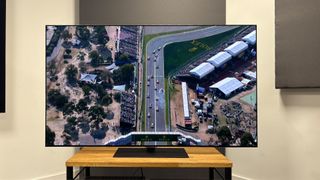
If we’re being honest, this isn’t the conclusion we were expecting to reach with the LG G5. At one point during our testing, it looked as though LG had knocked it out of the park, leveraging the new panel technology to stunning effect.
This TV is capable of delivering a truly exceptional picture, with bold highlights, rich colours and crisp details. In most regards, it ticks every box we look for in a five-star TV and represents one of the biggest jumps in OLED picture quality since the technology first emerged as a real contender roughly a decade ago.
But that Dolby Vision issue with streamed content is impossible to ignore. The problem is simply too obvious and will be too regularly encountered by most of the people who buy the TV.
If you simply never stream HDR movies and TV shows, by all means mentally add a fifth star to our rating. For everyone else, though, we recommend that you hold fire until we see whether LG can resolve this pesky flaw. If it can, the G5 will be a true force to be reckoned with.
SCORES
- Picture 4
- Sound 3
- Features 5
MORE:
Here are all of the best TVs you can buy right now
And these are the best TV deals
Lewis Empson is a Senior Staff Writer on What Hi-Fi?. He was previously Gaming and Digital editor for Cardiff University's 'Quench Magazine', Lewis graduated in 2021 and has since worked on a selection of lifestyle magazines and regional newspapers. Outside of work, he enjoys gaming, gigs and regular cinema trips.
- Tom Parsons
- Alastair StevensonEditor in Chief
You must confirm your public display name before commenting
Please logout and then login again, you will then be prompted to enter your display name.
